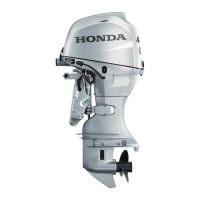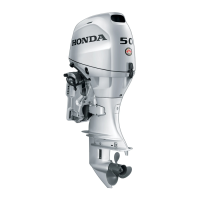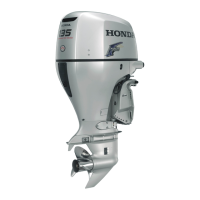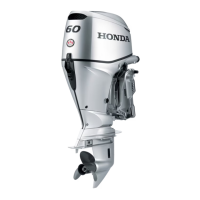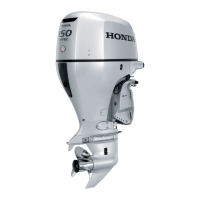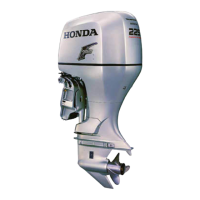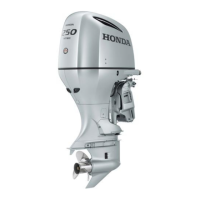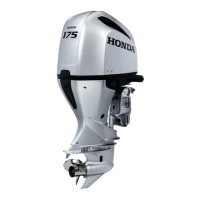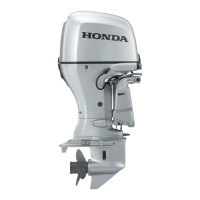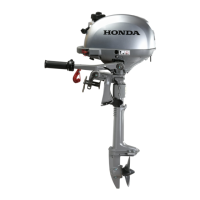Do you have a question about the HONDA marine BF30D and is the answer not in the manual?
Emphasizes the importance of safety and understanding hazards for operators and others.
Outlines the manual's purpose and general safety guidelines for operation.
Details the operator's duties to ensure safe use and understanding of controls.
Provides critical safety instructions for refueling and warns about carbon monoxide dangers.
Identifies the location and significance of safety labels on the outboard motor.
Explains model type codes used to identify specific control and feature applications.
Identifies the physical locations of key components and controls on the outboard motor.
Details ignition, emergency stop, throttle, gearshift, steering, and tilt levers for tiller models.
Covers ignition, emergency stop, and controls for remote systems.
Explains power trim/tilt switches and the tilt lock lever for angle adjustment.
Covers gauges (Trim Meter, Tachometer, Fuel Gauge) and indicators (Oil Pressure, Overheat, Cooling System).
Covers Anodes, Overrev Limiter, and Fuel System Components.
Advises on matching motor horsepower to boat capacity and transom thickness for installation.
Details correct positioning and height of the motor on the transom.
Explains motor attachment and adjusting the transom angle for propeller alignment.
Covers charging system and battery connections for powering the motor.
Emphasizes safety, knowledge, and readiness checks before operating the motor.
Lists essential safety and maintenance checks before using the outboard motor.
Provides safety guidelines and the break-in procedure for optimal motor performance.
Details starting procedures for both tiller handle and remote control models.
Explains how to start the engine manually using the emergency starter rope.
Details emergency and normal engine stopping procedures.
Describes gearshifting and throttle operation for tiller handle and remote control models.
Explains steering operation, friction adjustment, and trim for stable cruising.
Covers shallow water operation and procedures for mooring, beaching, and launching.
Stresses the role of proper maintenance and provides crucial safety precautions.
Outlines recommended service intervals for various motor components.
Covers checking, changing engine oil, and servicing spark plugs.
Explains fuel filter inspection/replacement and anode replacement for corrosion protection.
Provides instructions and safety precautions for replacing the propeller.
Details how to clean and flush the outboard motor after use, especially in salt water.
Explains flushing the motor using a water container without a hose adapter.
Advice on fuel storage, deterioration, and draining the fuel system for storage.
Lists recommended storage area conditions and precautions.
Covers securing the motor when trailering a boat or carrying it removed from the boat.
Addresses electric starter, engine not starting, and hard starting problems.
Covers engine overheating, oil pressure, and overheat indicators.
Immediate service steps for a submerged outboard motor.
Guides on recording product and engine serial numbers for parts and warranty.
Provides detailed technical specifications for BF25D and BF30D models.
Guides on finding dealers, contacting Honda, and obtaining manuals.
Outlines warranty types, coverage, exclusions, and procedures for US and Canada.
| Full Throttle RPM Range | 5000-6000 RPM |
|---|---|
| Cooling System | Water Cooled |
| Exhaust | Through Propeller |
| Lubrication | Wet Sump |
| Engine Type | 4-Stroke, SOHC |
| Displacement | 552 cc |
| Max Output | 30 hp |
| Rated Power | 30 HP (22.1 kW) at 5500 rpm |
| Starting System | Electric |
| Oil Capacity | 1.1 L |
| Trim & Tilt | Power Trim and Tilt |
| Propeller | 3-blade |
| Fuel | Unleaded Gasoline (86 octane) |
| Alternator | 12V 6A |
| Shaft Length | S: 381 mm (15 in), L: 508 mm (20 in) |
